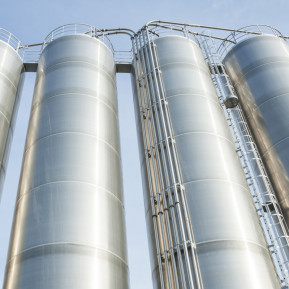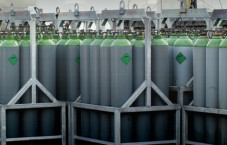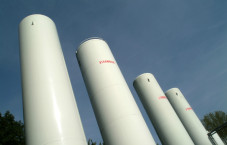Inertisation of storage tanks

For different foods, the residual amount of oxygen in the storage tank is important for the preservation time of the product. A too high oxygen content leads to oxidation or microbiological spoilage.
That is why a tank after cleaning or opening must be rinsed with an inert gas: nitrogen (N2) or carbon dioxide (CO2) to lower the concentration of oxygen to a level that is no longer harmful to the food (oxygen concentration < 1%). Nitrogen can be applied universally, CO2 only for carbonated liquids such as beer and soft drinks.
Also for tanks containing flammable products the oxygen content must be limited because of a risk of fire or explosion.
Applicable area
In the case of transport or storage tanks of liquid foods the tank is rinsed after cleaning.
Flammable products in tanks are sometimes kept in a nitrogen atmosphere, which is also at the same time used as propellants to pump the flammable product.
A special application is the degassing of hydrocarbon tanks using dry ice to be able to transport the tank safely. This technique is used amongst other by companies who dismantle old tank stations.
Requirements
- Framework or tank with nitrogen or CO2
- By use of a tank an evaporator is required
- Pipe decompressor
- For the inertisation of stationary tanks with flammable products a special fine regulator is fitted after the pipe decompressor
- Measuring device to measure residual oxygen or CO2
The quantity of oxygen in the air is 21%. To reduce this concentration to below 1% one needs at least four times the volume of the tank of inert gas used.
IJsfabriek Strombeek is your supplier of nitrogen or carbon dioxide and of the necessary equipment. Our team of engineers with all their experience and expertise are ready to help you organise your project.
Rinsing with nitrogen
For rinsing with nitrogen, it is preferably that the nitrogen gas is introduced at the top of the tank and then to let the residual gas escape at the bottom of the tank. Nitrogen is lighter than air and will drive the heavier oxygen to the bottom of the tank.
To keep tanks with flammable products under inert atmosphere you need one time the tank volume of nitrogen per filling of the tank.
Rinsing with CO2
The density of CO2 gas is higher than that of oxygen and therefore CO2 is preferably introduced at the bottom of the tank. The lighter gases escape at the top of the tank.
When rinsing with CO2 take into account that CO2 is ordered per kg and not per m3, 1 m3 weighs 2 kg. Therefore, you must multiply the volume of the tank by 4 (rinsing volume) and this outcome again with 2 (to convert volume to mass).
For the degassing of a fuel oil tank, one will be pouring dry ice into the tank. The dry ice will sublimate to gaseous CO2 and drive the hydrocarbon vapours out of the tank through the filling opening. When all the dry ice is vaporised, the tank is ready to be removed. The necessary quantity of dry ice: tank content (in m3) x 4 x 2 = kg dry ice (see above).
REMARK: It is always necessary after the cleaning and before releasing the tank to carry out the necessary measurements
Advantages
- A cheap gas ensures that the preservation time of the food is extended.
- Both nitrogen (E 941) as well as CO2 (E 290) are authorised additives in food.
- A CO2- or nitrogen rinsing is easy to automate.
- A nitrogen atmosphere in a storage tank does not affect the properties of the stored product.
- The nitrogen cushion can also replace a pump, which reduces the possibility of leaks.


